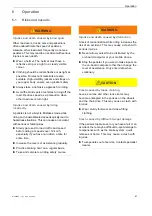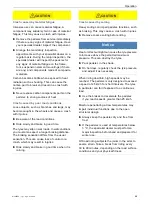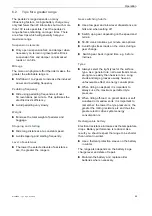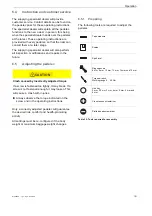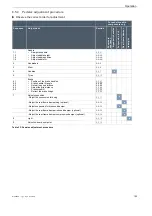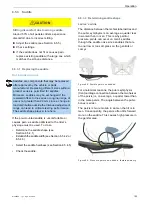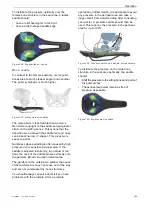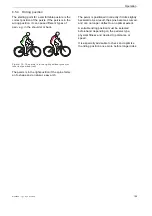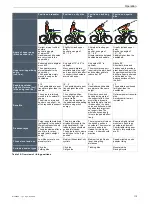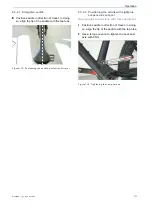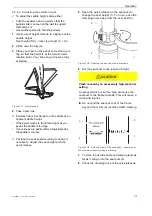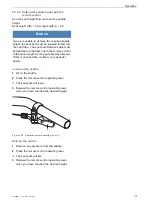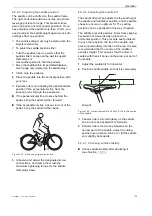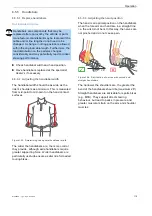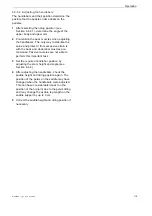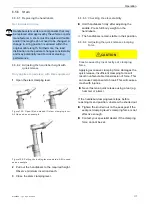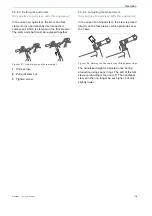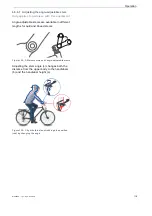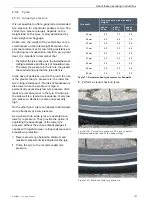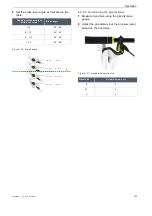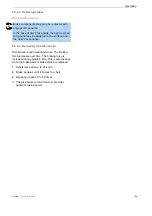
MY22Z0a - 12_1.0_25.07.2022
110
Operation
Position on roadster
Position on city bike
Position on trekking
bike
Position on sports
bike
Angle of upper body
(black dashed line)
Upright, almost vertical
posture,
back at an angle
of almost 90°.
Handlebars and handles
are very close to the
upper body.
Slightly inclined upper
body,
back at an angle of
60°…70°.
Sharply inclined upper
body,
back at an angle of
30°…60°.
Greater distance between
handlebars and saddle.
Greatly inclined upper
body,
Back at an angle of
15°…30°.
Saddle higher than the
handlebars.
Upper arm-upper body
angle
(red line)
Extremely acute angle at
around 20°.
The upper arms are
almost parallel to the
upper body.
The hands are simply
placed loosely on the
handlebars
An angle of 75°–80° is
optimum.
Many people prefer a
smaller angle of up to 60°
as it requires to less effort
to support the shoulders,
arms and hands.
An angle of 90° is
optimum.
The muscular support
required in the arms, back
and shoulder girdle is
reduced at 90°.
Above 90°
Shoulders, arms and
hands need to provide a
great deal of support, the
supporting muscles in the
back are heavily strained
and the load on the
bearing surface shifts to
the front.
Saddle-handlebar
height difference [cm]
(blue and green line)
>10
The handlebars are posi-
tioned far higher than the
saddle.
10… 5
The handlebars are posi-
tioned higher than the
saddle.
5… 0
Handlebars and saddle
are almost at the same
height.
< 0
The saddle is positioned
far higher than the
handlebars.
Benefits
The spine is intuitively
moved into its natural S-
shape.
The strain on arms and
hands is very slight – no
effort required to support.
The upright position
provides a good over-
view in traffic.
Force can be applied to
the pedals when pedalling
without using much
energy.
Shoulders, neck and
hands provide more of
the support effort, thus
promoting a dynamic,
agile riding style. Impact
is reduced on the back,
spine and buttocks, which
is particularly important
on longer rides. The
whole body can apply
force to the pedals effec-
tively.
Optimum power transmis-
sion.
Aerodynamic: low air
resistance.
Disadvantages
Force is applied relatively
inefficiently to the pedals.
Weight rests exclusively
on the buttocks.
The spine slumps after a
short time for many
people (pelvic straight-
ening).
The arms are often
stretched through to the
high handlebars – this
leads to tense shoulders
and painful hands.
The spine tends to slump
quickly due to the “high
position”.
There is greater strain on
the hands, neck and
shoulders. The muscular
system needs to be
trained for this higher
strain, i.e. riders should
practise.
Requires highly trained
muscles in back, legs,
shoulders, abdomen!
Comfortable riding posi-
tion only for people who
are fit.
Fitness level and use
Low fitness level, occa-
sional cyclists
Medium fitness level, city
cyclists
Medium to high fitness
level, riding long
distances
Speed-oriented, sports
pedelec riding
Suitable pedelec types
City bike
Folding bike
City bike
Cargo bike
Trekking bike
Mountain bike
Racing bicycle
Table 36: Overview of riding positions
Содержание 22-15-2061
Страница 274: ...MY22Z0a 12_1 0_25 07 2022 273 Documents Notes ...
Страница 281: ...MY22Z0a 12_1 0_25 07 2022 280 Documents 11 4 Charger operating instructions ABCDE ...
Страница 282: ...MY22Z0a 12_1 0_25 07 2022 281 Documents F 4A Charger DCG F H A I A J ...
Страница 283: ...MY22Z0a 12_1 0_25 07 2022 282 Documents F A I A J DCG F H ...
Страница 284: ...MY22Z0a 12_1 0_25 07 2022 283 Documents F DCG F H A I A J ...
Страница 293: ...MY22Z0a 12_1 0_25 07 2022 292 Appendix II Declaration of conformity for incomplete machine ...
Страница 294: ...MY22Z0a 12_1 0_25 07 2022 293 Appendix ...
Страница 295: ...MY22Z0a 12_1 0_25 07 2022 294 Appendix ...


